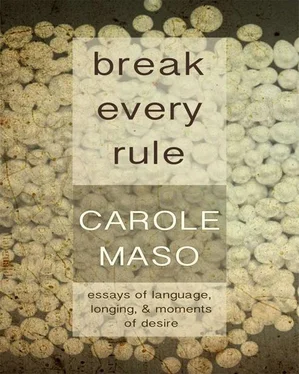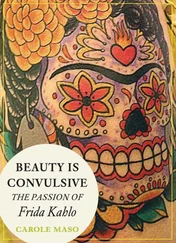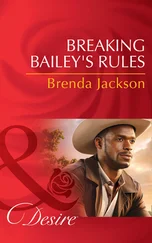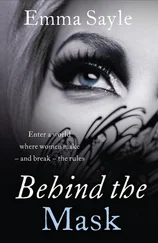Miracles might occur.
Jean-Luc Godard: “Cinema is not a series of abstract ideas but rather the phrasing of moments.”
New definitions of story and character may be required. To imagine story as a blooming flower or a series of blossomings. To change the narrative drive, to better mimic one’s own realities, drives. So that narrative might be many things. One hundred love letters, written by hand .
Understand and accept the limitations and contours of the traditional narrative. In The American Woman in the Chinese Hat , my third novel (published fourth), there is an end to narrative as I once understood it. Without going there first, I do not believe I could have gotten to AVA —which is something quite else.
And characters may be perceived as a light or a force or a pressure, or as an aspect of possibility.
In the negotiations between poetry and prose one might like something neater. Let’s put our mind to it:
To each — both lyrical fiction and poetry, a certain irresistible music. An Orphic voice speaking. A childish belief in the whole.
Is the sustaining of the lyric voice (certainly a kind of stamina) dependent on an insistent and pervasive sexuality? One feels an intimate link between the two.
The desire for—
Miracles.
Miracles. Helen reading my father the recipe for ravioli dough. He remembers his family drying pasta on all the beds in the Brooklyn house of his childhood. “Dig a well. Then put in eggs.” And I type it directly into the text of AVA , which I am working on in the next room. A place for the random, the accidental, the overheard, the incidental. Precious, disappearing things .
“Stay a little.”
I love you.
An expansive narrative. Bela Tarr’s Sátántangó —a terrifying film, filled with exhilarating narrative choices.
In my new work I want music, meditation, narrative, philosophy, more — and all at once.
I give myself room. The drama of the creative imagination being my one true subject. A continuous exploration made concrete, somewhat palpable, through fiction.
My aim in The American Woman in the Chinese Hat was to dramatize the breakdown of language, and with that carrying off of language, a belief system, a world. Much of the book’s drama is linguistic. The novel, being a spacious form, allowed me to establish the rules of language within a temporal framework and then, once established and understood, I could subvert them. This is one of the things novels do well. The world falls apart as you read. One hopes, by the end that the impact of the fractures are not only understood, but felt. Because having been engaged, involved in the fluency of images, when they begin to dissolve, one feels dissolved as well. Only shards remain, disrupted syntax, words detached from their meanings. A bleak code calling up the lost, the fluent, the integrated world, once whole. Language enacts the speed and degree and manner of breakdown. We are forced to witness an entire history: a world is born, evolves, warps and finally breaks. Breakdown is dramatized, imaginative and linguistic ways of escape are cut off.
She hears a high sound. Like mermaids or birds. She’s watching her hat. Strange angel. Butterfly .
To lose fluency. To become speechless.
The choice of lyrical techniques must augment and enhance the narrative decisions. Only then will the result be radiant, authentic, inevitable, grave.
Tarkovsky: “I think in fact that unless there is an organic link between the subjective impressions of the author and his objective representation of reality, he will not achieve even superficial credibility, let alone authenticity and inner truth.”
Much of my work is propelled by the desire to be reunited with lost, unremembered aspects of self and world.
Who were we, and why did we live?
Aspects of self, aspects of personality, temperament, take an outward shape and then are animated. Often, my obsessions, fears, hopes, all that matters most, grow heads, arms, legs and then move, interact with one another, in the form of characters.
Character, rather than well-rounded carriers of story, might work more like images do.
She waves. Wavers. In the agony of the afternoon. In a red dress. The American Woman in the Chinese Hat. She’s not American at all. She is German maybe, or Suédoise. And she has no hat .
Poetry and prose. How to reconcile poetic forms with the narrative requirements of an extended prose work? Because finally, yes, it is the novel I have to work in.
A new energy is needed to sustain a contemporary lyric fiction. The energy of writing into one’s desires, passion. The energy derived from many things might sustain such a voice. The energy from writing outside of fashion, against the fictive fashion, even. Easy to be a renegade in such an inauspicious fiction milieu. Use it to your advantage.
How to prolong the lyric moment?
What might the phrasing of moments look like in prose?
Rent Godard’s Pierrot le Fou .
The novelist’s lyric “I” engaged, as the epic poet is, in the world. A singer singing in relation to others. This perhaps defines the difference of the enterprise between lyric novelist and lyric poet.
The novel as huge, shifting, unstable, unmanageable canvas. Smudged with lipstick, fingerprints, crumpled, tear-stained, many-paged.
The novel as a geometry of desire.
A high sound like burning… Stranger. Light. The sound of water over stones. She waves. Each word in its watery globe. Pulses. Once, twice, good-bye. Love. Forever. A woman. Floating like a heart. And roses .
How to prolong the lyric moment?
In The American Woman with the Chinese Hat , the reiteration and gradual mutation of images mirror the disintegrating psyche of a narrator in the process of mental breakdown. The novel makes this acting out possible.
In a lyric novel, objects often are emanations of the unconscious.
I love winter most because it’s the most recognizable outward correlation I know of my interior life. There is recognition. Snowfalls like music .
What is narrative? Narrative might be:
I wrote you one hundred love letters.
One thousand love letters, written by hand.
This is probably the last love letter I will ever write.
One thousand love letters — you probably never got them all .
Prose, it seems to me, has the great ability to dramatize states of mind, as well as incorporating other kinds of “action” and development.
In AVA though there are elements of story everywhere, I am still reluctant and unprepared to say what the story is.
A polyphony. A bouquet of voices.
The storyteller as chameleon. Fluid, mutable.
The novel is all potential. All what might be. All what might have been. A record of all we cannot remember, all we’ve lost — never to be retrieved.
Despite my efforts, it resists me, eludes me. Perhaps it might be possible to write a perfect poem, but I do not believe it is possible, or even desirable, to write the perfect novel. That is what I love most about the form.
It is as rebellious, as unruly as I am.
There is another kind of novel other than the novel of adventure, the novel of manners, the psychological, the realist novel. It is strange, exotic, hybrid — and it is beautiful.
Lyrical fiction introduces the conventions of poetry (image, metaphor) into a genre dependent on causation and time. Characters, scenes, plots are turned into patterns, designs of imagery. Life and manners are sensually apprehended and then turned into design.
Lyrical novels are concerned with aesthetic relations — space, temporal and shape relations, tone and tempo. They are sensitive to tensions and pulls, resistances — gatherings and release.
Читать дальше












